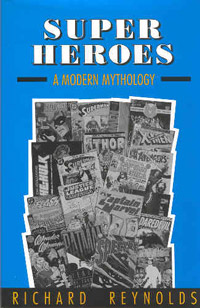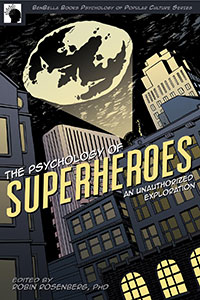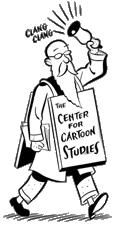 Alan Moore crafts a dreamlike mythos for Promethea (1999-2005) that is both expansive and introspective, allowing him to explore imagination as a magical force in what on the surface looks to be a trippy superhero saga. This coming-of-age origin story has an eternal goddess merge with the college student Sophie, her new human avatar, as both adjust to new bodies, new personalities, new powers, and new realities. Sophie lives in a futuristic New York City but is suddenly transported to Immateria, where imagination rules and the previous incarnations of Promethea gather to help the “new girl” get up to speed with her mystical powers of imagination before she can be destroyed by various demons, magicians, or evil cabals… all en route to a series-ending apocalypse. Particularly fascinating about Promethea is how by-now standard elements of superhero stories are subverted with innovative female-centric story-telling and visually blended with psychedelic dreamscapes, all while Moore offers his own metacommentary on comics. In this first volume, we are introduced Promethea’s universe and it’s central theme: the stories we immerse ourselves in affect who we are, and we can become whatever we imagine ourselves to be. Moore has his critics, to be sure, but Promethea is a rare breath of fresh air for superheroines.
Alan Moore crafts a dreamlike mythos for Promethea (1999-2005) that is both expansive and introspective, allowing him to explore imagination as a magical force in what on the surface looks to be a trippy superhero saga. This coming-of-age origin story has an eternal goddess merge with the college student Sophie, her new human avatar, as both adjust to new bodies, new personalities, new powers, and new realities. Sophie lives in a futuristic New York City but is suddenly transported to Immateria, where imagination rules and the previous incarnations of Promethea gather to help the “new girl” get up to speed with her mystical powers of imagination before she can be destroyed by various demons, magicians, or evil cabals… all en route to a series-ending apocalypse. Particularly fascinating about Promethea is how by-now standard elements of superhero stories are subverted with innovative female-centric story-telling and visually blended with psychedelic dreamscapes, all while Moore offers his own metacommentary on comics. In this first volume, we are introduced Promethea’s universe and it’s central theme: the stories we immerse ourselves in affect who we are, and we can become whatever we imagine ourselves to be. Moore has his critics, to be sure, but Promethea is a rare breath of fresh air for superheroines.
Notes one review: “Moore sets up traditional superhero structures — oh, no, a band of demons are attacking a hospital! how will Sophie transform into Promethea to save the day? — and then undercuts the reader’s expectations. Instead of a solo hero evoked through some grandiose gesture, Sophie uses poetry to open the door and then brings through multiple versions of female power. Or she ends a decades-long vendetta through amusing the next generation instead of battling them. The ability to improvise outside of existing patterns is Sophie’s strength.”
Here’s a glimpse of superheroines in comics during the rise of Feminism!
Some key terms in Feminist Criticism here and here. Also interesting is Promethea’s contrast with the “Women in Refrigerators” syndrome (an overview here) in terms of characterization and visual representations of women.



















I enjoyed this reading, oddly enough I felt like I was reading a “Men in Black” spinoff?
After reading I finished the wonder women comic and can safely say that both views on Feminine portrayal are drastically different as are they convincingly entertaining in their separate archetype mythos.
By: ERIKsharifRABAH on March 29, 2010
at 2:34 am
REFLECTION QUESTIONS:
1) How does Promethea differ from the superhero narratives we’ve encountered thus far, both in narrative structure and in terms of how her powers are used in solving conflict? Contra to L&J’s claim that superheroic action discourages reflective thought, do Promethea’s abilities of Magical Imagination offer a counter-masculine model for feminine power, or is she exemplary of L&J’s “Heidi Redeemer”?
2) Some have compared Promethea’s superheroine to various amounts of Sandman, Shazam, and of course Wonder Woman. Which superhero and mythic tropes does Moore draw most heavily upon? Does the occultism and magic that Promethea explores have spiritual or existential messages that invite reflection upon our daily practices? Upon the unique imaginative power of the comics medium?
3) What similarities between Promethea and Wonder Woman can you identify in this origin story? Are there elements of the Classical Monomyth present that mitigate the Superhero Monomyth? How are each of the previous Prometheas emblematic of their own times, and differing aspects of feminine archetypes? Why aren’t men able to realize the power of Promethea, and what roles do males assume within this female-centric tale?
4) What do you think of the “Women in Refrigerators” syndrome?
5) Is Promethea a feminist superheroine? Compared to Wonder Woman, what themes or elements offer an empowering view of feminine power? What themes or elements are problematic? Like Wonder Woman, what contradictions do we encounter with warriors for peace and love?
By: Doc T on March 29, 2010
at 8:27 am
For Lawrence & Jewett, domestic “Heidi Redeemers” are those who save the community through miraculous conversions via mental/emotional manipulations that invite audience members to emulate their amazing feats in real life (they used examples of Heidi and Touched By An Angel). These feminine redeemers possessing extraordinary optimistic innocence and child-like purity (some of which can be male) are popular in fictions but emulations in real life unfortunately discover “… that targets of redemption are not as easy to change as one might expect… cheerful Heidis do not generally succeed in reconciling alienated oldsters to church and community” (p83); and those waiting for a Christ-like redemptive hero (or the calling to become one) to arise have “no patience for working with institutions or working on social justice as a way of improving the world” (p 332). I cannot help but conjure images of the manipulative self-martyr whose passive-aggressive nagging and holier-than-thou self-righteous mission to save us from ourselves has become a recurring doppelgänger for the Heidi Redeemer.
Whereas the superhero most often uses their moral purity for redemptive violence, the Heidi Redeemer deploys it in prophetic persuasion aimed at moral conversion. The authors thus find the antidemocratic superheroic crusading intact by other means, then further explain the shortcomings of this variation upon the monomyth:
“The myth teaches those seeking to emulate superheroes not to place their cards on the table, not to admit their own emotional needs, and hence always to assume the attitude of the injured servant when thwarted. When the stance of the innocent savior proves futile, explosions of indignation are imminent. Frustrating reality can turn domestic manipulators into male and female bitches. Massaged by the myth to believe that they require no growth or adjustment to adversity, would-be superheroes and –heroines have a disconcerting tendency to withdraw from sustained encounters with reality” (p84).
By: Doc T on March 29, 2010
at 8:46 am